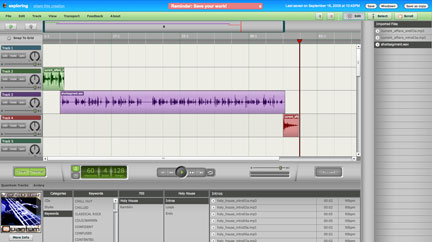The new, free online tools keep coming. Here is an online audio editor called Myna (Aviary, Inc.). I think of this product as an audio-only Garageband. Maybe something else will come to me as I explore some more. You put together your audio creation from clips that are provided, record audio, or upload audio you already have. You can overlay tracks, fade-in, fade-out, etc. If you have used Garageband, you understand the basics and can pretty much just begin creating. When finished, you first mix-down your tracks and then share.
It is pretty late so I uploaded a short segment of audio I used as part of a demo podcast created some time ago (in this case without the images) and combined this upload with some music segments available from the Myna library. It was a fairly basic undertaking, but enough of an exercise for me to explore the application and offer something as an example (see link to short audio product below).
I would think this tool would be great for creating podcasts.
![]()

You must be logged in to post a comment.